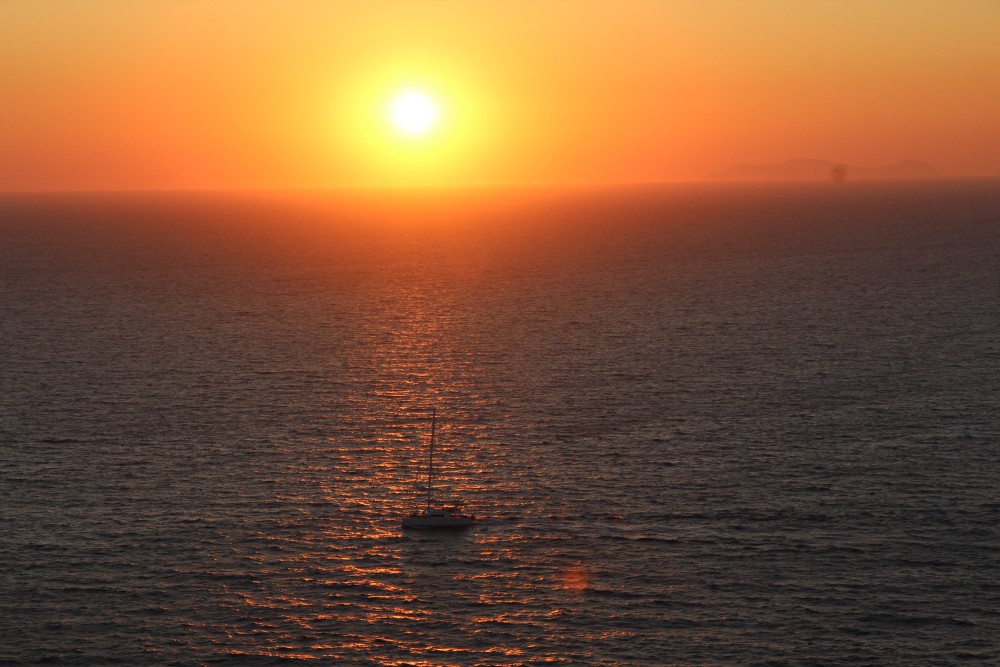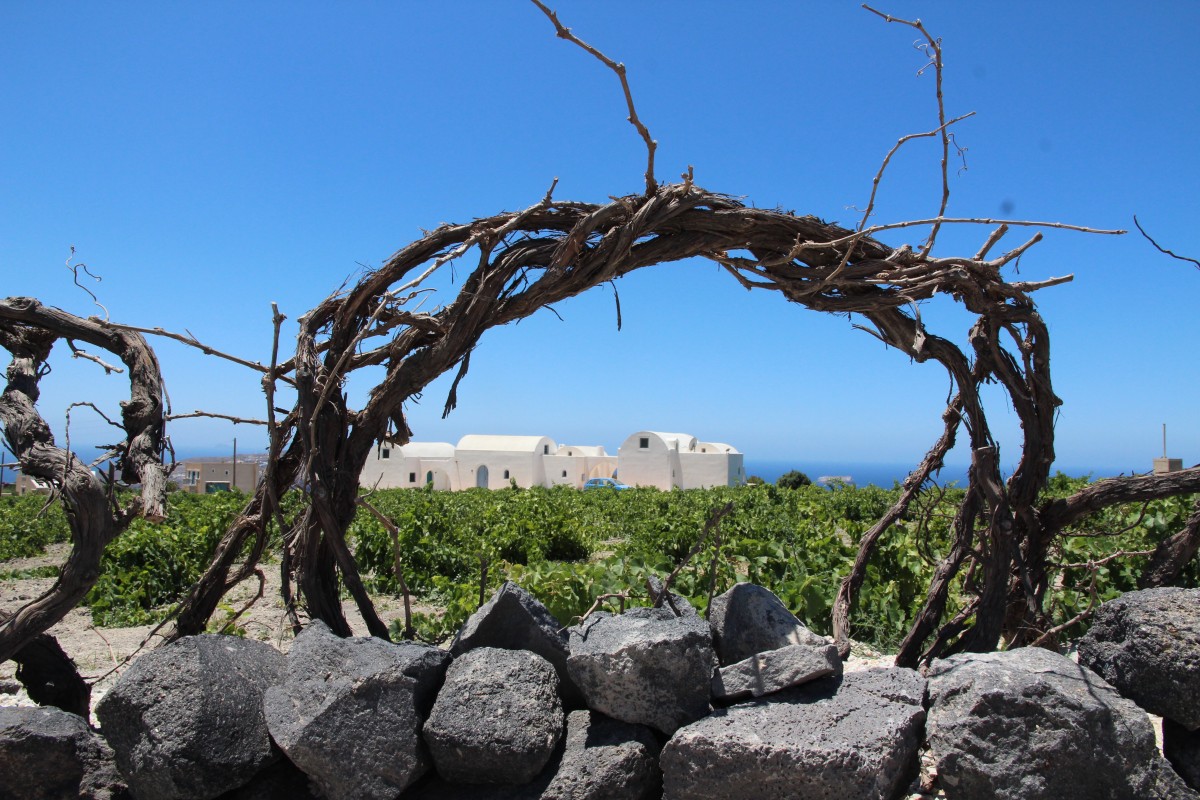I confess, I didn’t really plan a trip to Santorini this year. Even though it had been 2 years since I last been there, a trip I had after also waiting 2 years to get back. It did cross my mind, but, rationally speaking, I didn’t have the time, or the budget… But, around the start of August, Yiannis Karakasis MW published an article in which he predicted an historically low harvest on the island. And, because of that, he predicted a new jump in the price of grapes and, obviously, wines… What would a normal person do in that instance? He would’ve minded his business. I…went to Santorini…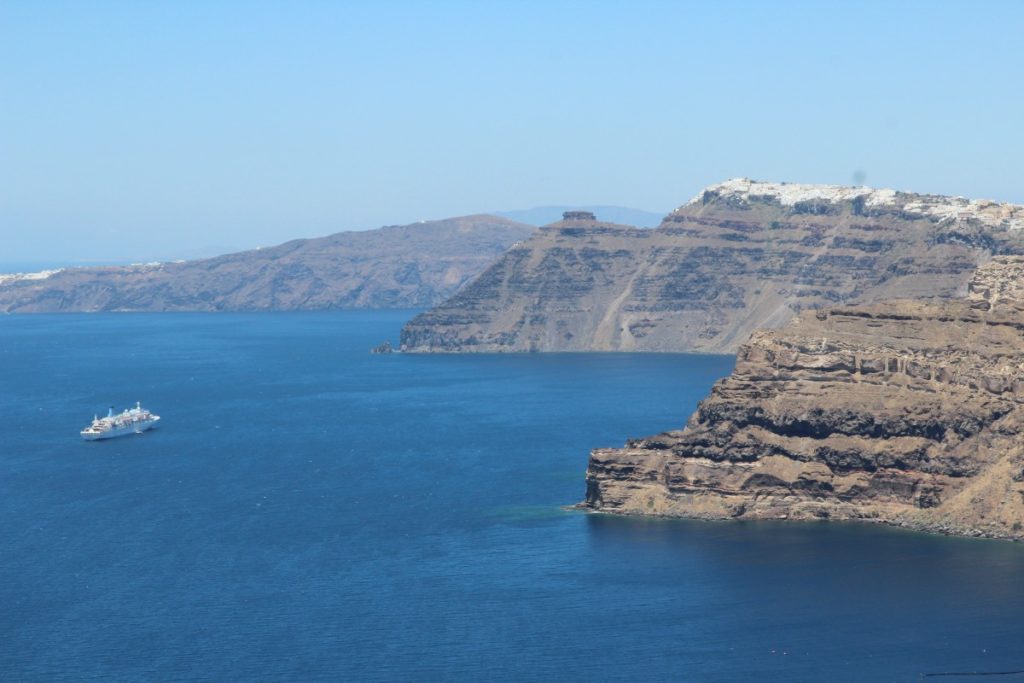
Day 1
On the 4th of September, 6:30 in the morning, I was in Piraeus. I booked my tickets early, so all I had to do was go on the ferry and search for a place to sit and wait for the next 7 and a half hours. What can I say, smaller budget, so no Sea Jet for me… But, if you’re not in a hurry, I greatly recommend the trip with the “monsters” from Blue Star. More than civilized conditions, and, on top of that, you get a better feel of things. And of people. Locals and tourists. And you also add the fact that you stop in places such as Paros, Naxos or Ios, so you could think of future holiday destinations. (Naxos rules. I’m going there next year. They don’t really have wines, but maybe Alina Iancu would let me join her team and write about cheese. The insland is renouned for that). At 3:00 in the afternoon, I was in Santorini. With a pleasant delay of only 15 minutes. I say pleasant, because, back in 2015, I had the “chance” to get a delay of 3 hours. The car I rented was there. Well, If you could call it a car. It was a Fiat 600, automatic transmission. Perfect for a flat city, but definitely not my choice for driving over volcano slopes. I had enough time to also get to Kamari, where I had gotten myself a room. I left my toothbrush and my flip-flops there, and I was off to work…
Vassaltis
 The first visit is in the northern area, at Yannis Valambous. The majority shareholder of Vassaltis Winery. He has 7ha of vineyard in his property and around 5 more which he rented. The winery, modern and very well put together, can deliver around 100.000 bottles a year. Not this year, however. “Only 1000 tonnes of grapes have been made on the island. After 3 years of drought we also had really strong winds in the spring, which effectively pulled out the flower from the vine. In our vineyard, during a normal year, we could normally obtain around 3 tonnes of grapes per hectar. This year we had portions of 1,5 tonnes, others with 2. But that is because we take good care of our vineyard. A lot of people don’t do that anymore. So, because of that, in a lot of areas, the average was around 600 kilograms per hectar”.
The first visit is in the northern area, at Yannis Valambous. The majority shareholder of Vassaltis Winery. He has 7ha of vineyard in his property and around 5 more which he rented. The winery, modern and very well put together, can deliver around 100.000 bottles a year. Not this year, however. “Only 1000 tonnes of grapes have been made on the island. After 3 years of drought we also had really strong winds in the spring, which effectively pulled out the flower from the vine. In our vineyard, during a normal year, we could normally obtain around 3 tonnes of grapes per hectar. This year we had portions of 1,5 tonnes, others with 2. But that is because we take good care of our vineyard. A lot of people don’t do that anymore. So, because of that, in a lot of areas, the average was around 600 kilograms per hectar”.  Yannis is not optimistic at all about the future. “Let’s not imagine that, even if we get the best year possible climate-wise, we’ll get that many more grapes. The vine is very old, it is dying, and a lot of portions are not worked on anymore. A lot of people know that the base of Santorini wines is made up of the quality of the plantations and of the grapes. But, just as there are people on the island who want to mantain the vineyards and the tradition, there are also people who aren’t interested at all; they only come to get grapes and win”. Him being mad is sort of understandable. Even though he got around to paying 4.5 euros per kilo of grapes, his production will be somewhere around half of what it usually is. However, it appears that it will be a reference year in terms of quality. “With the way things are going, we want to say that 2019 is a year of very good quality. But we’ll get the final verdict once the wines are done”.
Yannis is not optimistic at all about the future. “Let’s not imagine that, even if we get the best year possible climate-wise, we’ll get that many more grapes. The vine is very old, it is dying, and a lot of portions are not worked on anymore. A lot of people know that the base of Santorini wines is made up of the quality of the plantations and of the grapes. But, just as there are people on the island who want to mantain the vineyards and the tradition, there are also people who aren’t interested at all; they only come to get grapes and win”. Him being mad is sort of understandable. Even though he got around to paying 4.5 euros per kilo of grapes, his production will be somewhere around half of what it usually is. However, it appears that it will be a reference year in terms of quality. “With the way things are going, we want to say that 2019 is a year of very good quality. But we’ll get the final verdict once the wines are done”.
I also met Aristotelis, the young winemaker, who is half Romanian, that just started working alongside the more experienced Yiannis and Elias. I wished him luck, and I promised him that I will send him an invitation to come to Romania once the first Assyrtiko will be made on home-soil. I tested around three wines from the previous harvests: Santorini 2018 is in the style that made it what it is, with a direct expression, full of power, with pleasant minerality that is very well framed in a surpisingly full body for a harvest considered to be not that great. Santorini Barrel Aged 2017 is now a beauty: the wood has blended in perfectly and the unctuous notes greatly balance the surges of acidity and minerality of the variety. But the biggest surprise for me was Vassanos, a 2018 Mandilaria that is fresh and weirdly friendly, with no sign of the aggresiveness you usually find in the tannins of this variety. I bought a bottle of it! With the thought that it would work very well with the paidakia my friend Stelios made for me, back in Salamina… It worked a charm!
Domaine Sigalas
 Me and Paris Sigalas became friends when the renouned producer from Santorini came to visit Bucharest. Apparently, knowing a bit of French sometimes helps. Now, when announcing my plans to visit, Paris told me: “whenever you want, Horia!”. To be honest, that’s really something I’m prideful about. I got near Oia around 18:30, but I only saw Paris around 20:30. He was in the winery to taste the new wines. I can’t say that I got bored. I met Thalenia, a student in oenology in Athens, who was in Santorini for practice. When I told her that I’m a friend of her favorite professor, Evanghelos Beris, I suddenly became a VIP. I even got a glass of Kavalieros 2014, a poem. Until I started talking to Paris Sigalas, I also met Argyro Frantzeskaky, the winery’s enologist, and a good friend of my muse from Santorini (and not only), Stavroula Liapi.
Me and Paris Sigalas became friends when the renouned producer from Santorini came to visit Bucharest. Apparently, knowing a bit of French sometimes helps. Now, when announcing my plans to visit, Paris told me: “whenever you want, Horia!”. To be honest, that’s really something I’m prideful about. I got near Oia around 18:30, but I only saw Paris around 20:30. He was in the winery to taste the new wines. I can’t say that I got bored. I met Thalenia, a student in oenology in Athens, who was in Santorini for practice. When I told her that I’m a friend of her favorite professor, Evanghelos Beris, I suddenly became a VIP. I even got a glass of Kavalieros 2014, a poem. Until I started talking to Paris Sigalas, I also met Argyro Frantzeskaky, the winery’s enologist, and a good friend of my muse from Santorini (and not only), Stavroula Liapi.
“If we want to only see the bright side of life, we can say that this catastrophic year in terms of quantities is because of the weather. But that is a happy interpretation. The other is way, way worse. The vine from Santorini is very very old, and, to make it worse, it’s not worked on. We don’t have viticulturists who love what they’re doing anymore. I think there’s more people who work on tourism than they do on the vineyards. Santorini has real problems, and important decisions have to be made, we have to change something”. The start of the conversation was quite frankly, sharp. I was eyes and ears, because Paris Sigalas, a legend in Santorini, wasn’t usually that talkative. But apparently, he couldn’t take it anymore. “This year marked the lowest ever production for me, 40% smaller than the one from last year, which also wasn’t that great. The problem is that more and more people are starting to battle over less and less grapes. Renouned domains just suddenly appear wanting to make Assyrtiko from Santorini. And the price just goes up. Assuming this continues, the historical domains from Santorini will either close down, or do what I do, buy grapes from other areas of Greece. Yes, next year, on the market, you’ll find Cabernet Sauvignon and Syrah from Sigalas. There’s no other way to survive”.
 The discussion, which was more of a monologue that I rarely interrupted with my questions, lasted for more than two hours. And it touched a lot more problems, including the Nyxteri (Nychteri) method, which is not very well reglemented, that could be lost in the near future. We also talked about the rain during spring-time, “something that shouldn’t ever exist in Santorini. The biggest quantity of water in my history here”, which could assure a way better harvest next year. We also talked about the fact that many producers who depend on the grapes they buy from different vineyard owners have gotten around to paying more for Athiri and Aidani, just so they can be sure that the providers will give them Assyrtiko 100%. But everything comes back to the problem of the people: the youngsters who don’t want to work in the vineyards anymore, the owners of the vine who don’t have the passion to work on it, the new-comers who only buy grapes and the people who still don’t agree with some changes, which, in Paris Sigalas’ opinion, are mandatory. Such as permission to irrigate plantations. Or permission to plant other varieties of grapes. “As long as we’re prohibited to plant other varieties, why are others allowed to come to Santorini?”… I leave, but not for long, because Paris invited me over the second day as well. “I have a surprise for you”, he told me…
The discussion, which was more of a monologue that I rarely interrupted with my questions, lasted for more than two hours. And it touched a lot more problems, including the Nyxteri (Nychteri) method, which is not very well reglemented, that could be lost in the near future. We also talked about the rain during spring-time, “something that shouldn’t ever exist in Santorini. The biggest quantity of water in my history here”, which could assure a way better harvest next year. We also talked about the fact that many producers who depend on the grapes they buy from different vineyard owners have gotten around to paying more for Athiri and Aidani, just so they can be sure that the providers will give them Assyrtiko 100%. But everything comes back to the problem of the people: the youngsters who don’t want to work in the vineyards anymore, the owners of the vine who don’t have the passion to work on it, the new-comers who only buy grapes and the people who still don’t agree with some changes, which, in Paris Sigalas’ opinion, are mandatory. Such as permission to irrigate plantations. Or permission to plant other varieties of grapes. “As long as we’re prohibited to plant other varieties, why are others allowed to come to Santorini?”… I leave, but not for long, because Paris invited me over the second day as well. “I have a surprise for you”, he told me…
Around 11 in the evening I was in Pyrgos, to drink a glass of wine with my muse, Stavroula. I was extremely tired, but I somehow resisted. I got an Aidani Hatzidakis, which was actually training for what was to come the next day…
Day 2.
Early bird catches the worm. I have work to do today, and I also want to take a swim in the sea. In Kamari, you find, probably, the best beach. A normal one, neither white nor black, nor red. Sure, you can always say – without any chance of being contradicted – that the beach in Kamari is also black, because of the basaltic stones. But you can also find a bit of sand, and the entrance in the water is by far the smoothest. And there’s barely any rocks in the water. Sure, every 5 minutes your pulse gets higher, when a plane gets ready to land on the island, but, besides that, it is very nice. Even the coffee is drinkable! Sure, Santorini prices, around 4 euros for an espresso. But it’s good…I’m not there for too long, because at 10, I have to arrive at…
Estate Argyros
 Freshly relocated in a new house, the domain is superb. Dominated by the vines from Epsikopi, which, almost fully, belong to the family. Argyros has 130 hectars of vine in its property, which, for Santorini, is immense. And it produces aroun 400.000 bottles during a normal year. And some bag-in-box, which is, however, only sold on the island, to some restaurants and taverns. Since 2018, it has a new winemaker, Michalis Probonas, who lastly worked for Antonopoulos, in Peloponese. A full-on professional, who already put his touch on the wines. Michalis was the one who told me about what became my new love from Santorini, Cuvee Monsignori, the wine that got the Great Trophy at Balkans International Wine Competition this year.
Freshly relocated in a new house, the domain is superb. Dominated by the vines from Epsikopi, which, almost fully, belong to the family. Argyros has 130 hectars of vine in its property, which, for Santorini, is immense. And it produces aroun 400.000 bottles during a normal year. And some bag-in-box, which is, however, only sold on the island, to some restaurants and taverns. Since 2018, it has a new winemaker, Michalis Probonas, who lastly worked for Antonopoulos, in Peloponese. A full-on professional, who already put his touch on the wines. Michalis was the one who told me about what became my new love from Santorini, Cuvee Monsignori, the wine that got the Great Trophy at Balkans International Wine Competition this year.
 All the other details were given to me by Elisavet Loukaki, Export Manager. She recieved instructions from Matthew Argyros and from Evanghelos Beris to respond to all of my questions. Before all that, however, she shortly told me the history of the domain, a history that started well over 200 years ago. When the church, then catholic, offered the family the right to work on the plots now called Monsignori and to produce, evidently, for the church, Vinsanto. Basically, the Argyros domain started in 1903, Matthew being the representative of the 4th generation of viticulturists. The domain takes pride in its achievements in Vinsanto – 100 Wine&Spirits points for 1992 and 98 Parker points for 1994 – but also in the fact that it was the first producer to vinify Aidani as a separate variety, in 2004…And then we got to serious business. What is going on in Santorini?
All the other details were given to me by Elisavet Loukaki, Export Manager. She recieved instructions from Matthew Argyros and from Evanghelos Beris to respond to all of my questions. Before all that, however, she shortly told me the history of the domain, a history that started well over 200 years ago. When the church, then catholic, offered the family the right to work on the plots now called Monsignori and to produce, evidently, for the church, Vinsanto. Basically, the Argyros domain started in 1903, Matthew being the representative of the 4th generation of viticulturists. The domain takes pride in its achievements in Vinsanto – 100 Wine&Spirits points for 1992 and 98 Parker points for 1994 – but also in the fact that it was the first producer to vinify Aidani as a separate variety, in 2004…And then we got to serious business. What is going on in Santorini?
For Argyros, 2019 wasn’t really a disaster. “Our loss is not that big. The production is only about 30% less compared to a normal year. But that is because we have our own vineyard and we take good care of it”, said Elisavet. But, even there, the wine-related future of the island doesn’t sound that good: “The vine is getting older, it has been producing, on average, for around 145 years. It’s getting tired. The island, also, is getting more and more urban. People aren’t interested in vineyards anymore. The climate conditions are changing. It’s time for us to also change something”. This is also the reason why Argyros started a new process of renewing the vines a few years ago. Renewing, not replanting, because “nothing new gets planted 100% in Santorini. It wouldn’t resist”. Another problem is the great congestion in the island. “More and more people want to make wine in Santorini, but most of them only buy grapes, they have no interest in buying a vineyard. We almost fully work in an organic system, only intervening with a few sulfits in the vine. We even do the weeding by hand”, continued Elisavet, adding that “sometimes, it’s cheaper to buy grapes than to organically cultivate them. We sometimes buy as well, but only use them for the Atlantis range (n.a. – the domain’s blends) and for bag-in-box”.
 The discussion lasted for over two hours. Time in which I tasted Estate Argyros Aidani 2018, Estate Argyros Santorini 2018, Cuvee Monsignori 2017 and Vinsanto 2012, with 4 years of wood. I’m only going to talk about the last one and let you try the others for yourselves. If you’ll do that in a year or two…even better… So, Vinsanto 2012 with 4 years of wood maturation. It is a blend of 80% Assyrtiko and 10% each of Aidani and Athiri, late harvest. The grapes, collected together, are dried on a bed of wood for 12 to 14 days. Everything ferments together, in barrels used for the 2nd or 3rd time. Once fermentation is done, the wine is left to mature in 500 litre barrels made out of french oak for 4, 12 or 20 years. I elected to try the 4 year old wine because it is the easiest to understand. The freshest. And the aromas of sweet citrus fruits, honey and herbs aren’t yet dominated by balsamic notes, like you’d find in the wines that spend more time in the barrel. I also bought it, because I liked it…
The discussion lasted for over two hours. Time in which I tasted Estate Argyros Aidani 2018, Estate Argyros Santorini 2018, Cuvee Monsignori 2017 and Vinsanto 2012, with 4 years of wood. I’m only going to talk about the last one and let you try the others for yourselves. If you’ll do that in a year or two…even better… So, Vinsanto 2012 with 4 years of wood maturation. It is a blend of 80% Assyrtiko and 10% each of Aidani and Athiri, late harvest. The grapes, collected together, are dried on a bed of wood for 12 to 14 days. Everything ferments together, in barrels used for the 2nd or 3rd time. Once fermentation is done, the wine is left to mature in 500 litre barrels made out of french oak for 4, 12 or 20 years. I elected to try the 4 year old wine because it is the easiest to understand. The freshest. And the aromas of sweet citrus fruits, honey and herbs aren’t yet dominated by balsamic notes, like you’d find in the wines that spend more time in the barrel. I also bought it, because I liked it…
Hatzidakis Winery
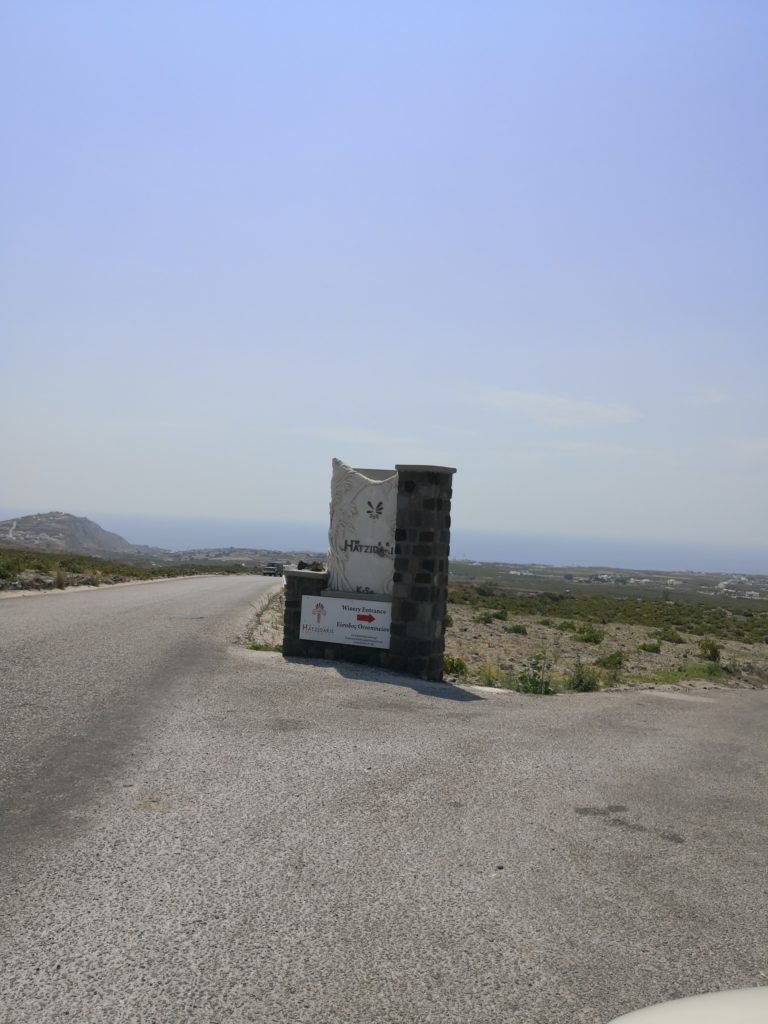 It’s almost 2 o’clock, so I ran to Pyrgos. Well, ran is an euphemysm, because I’m sure you already know that it is pretty hard to go up 20 degree slopes in a Fiat 600. I didn’t have time to stop at Taverna Kallisti, where you probably eat the best tomato-balls (tomatokeftedes), because, at a kilometre from the city, my muse was waiting for me. Yes, Stavroula Liapi, who, this year, came back to Santorini for the campaign. But not at Sigalas, at Hatzidakis. To be honest, her being on the island convinced me to go as well. I didn’t get to ask for a lot of details about Hatzidakis, but Stavroula told me that it’s fine…
It’s almost 2 o’clock, so I ran to Pyrgos. Well, ran is an euphemysm, because I’m sure you already know that it is pretty hard to go up 20 degree slopes in a Fiat 600. I didn’t have time to stop at Taverna Kallisti, where you probably eat the best tomato-balls (tomatokeftedes), because, at a kilometre from the city, my muse was waiting for me. Yes, Stavroula Liapi, who, this year, came back to Santorini for the campaign. But not at Sigalas, at Hatzidakis. To be honest, her being on the island convinced me to go as well. I didn’t get to ask for a lot of details about Hatzidakis, but Stavroula told me that it’s fine…
I wasn’t fully convinced, because I knew that, back in 2017, when Haridamos decided to move the Styx, the winery suffered because of it. Famous plots have been lost (n.a. – such as Mylos for example), and the production greatly decreased. As I was told by Stella Hatzidakis, from 100.000 bottles in 2016, the following years, in 2017 and 2018, the winery barely scraped 40.000 bottles. But even so…
Hatzidakis now owns two hectars in its property, but they also have 8 hectars in administration. Hectars owned by good friends, with which the producer had excellent relationships during the 22 years of activity for the winery. And, very importantly, the Louros plot is back in the Hatzidakis portofolio. Surprisingly, although 2019 is the year with the lowest harvest, Stella hopes that this year will also provide 40.000 bottles. “Pyrgos wasn’t that affected by the storms during the spring, and, out friends, the viticulturists, took very good care of their vines. And, because of the rains, our vineyard produced more than usual. So the loss was smaller than in other places. We also bought some grapes, but, even if we had a bigger harvest, we still would’ve only produced 40.000 bottles, because we want to remain a boutique winery. We don’t want the Hatzidakis philosophy to suffer”. Alongside Stella, 3 other girls who make the wines this year have appeared. Stella Papadimitriou, Marietta Samara and my muse, Stavroula Liapi. The discussion flows naturally, everybody has a certain opinion about the current state of the island, but the conclusions are mostly the same.
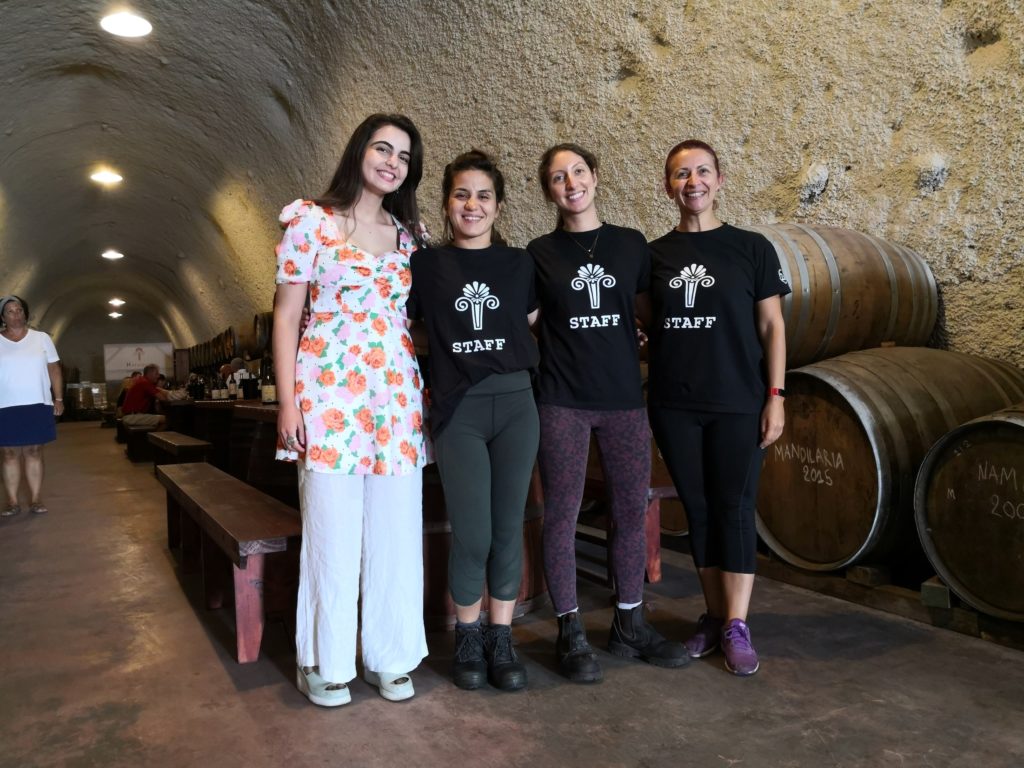 The reasons for the decreased harvest were the climate problems in 2018 and 2019, but also, mostly because of the fact that there are less and less grape producers. “A lot of plots are owned by people who aren’t interested in vines anymore. They have coffee shops, taverns, pensions. But they don’t want to sell. Why sell when you could get 5 euros for a kilo of grapes?”
The reasons for the decreased harvest were the climate problems in 2018 and 2019, but also, mostly because of the fact that there are less and less grape producers. “A lot of plots are owned by people who aren’t interested in vines anymore. They have coffee shops, taverns, pensions. But they don’t want to sell. Why sell when you could get 5 euros for a kilo of grapes?”
I grabbed the bull by its horns and asked if there’s any conflict between the traditional producers and the newcomers. “Calling it a conflict would be too much, but there are some misunderstandings. Until 2010, there were only 7 producers on the island, now, there are 19. Because a lot of people have realized what Santorini brings in terms of image potential. What is certain now, however, is the fact that everybody realized that problems exist. And they have started talking about what to do to solve them. But they’re at the beginning. It’s hard for 19 people to get to an agreement that fast. My father noticed these a few years ago. He told me that tough times were ahead”, said Stella Hatzidakis, nonchalantly. And she added: “Whatever happens, even if we get to only making 20.000 bottles per year, we won’t buy low quality grapes and we will never buy grapes from outside the island. Our path will continue with the Hatzidakis philosophy!”
The winery got crowded and Stella got up to greet a group of tourists. I remained there with the three wine-creators and started the tasting. The first was Santorini Familia 2018, a wine made up of only grapes from the Pyrgos plantations. Beautiful acidity, minerality even more so, but I feel like I didn’t find that specific lemon-peel. Maybe also because of the wine’s age. It was younger. I then continued with Skitali 2016, the first edition of this wine which ferments with natural yeasts for 45 days. At a temperature of 17-18 degrees. And which, afterwards, stays on yeasts for 12 months. That’s another story… What I can say is the fact that you can only find this wine in the winery… The girls lured me with a lot of wines. But, because I haven’t yet finished my day, I only wanted to see a couple of them. The newcomers and the favorites. So I also tried Rosette 2018, 100% Mandilaria, a rose made up by direct pressing, without maceration, because the varietal is extremely tanic. Dense, with a red fruit explosion balanced in the end by tonic-mineral notes. I then continued with one of my passions. The only thing was that the Mavrotragano 2016, while barreled for 18 months in a french barrel used for the third time and then left a year in the bottle, is still fairly young and pretty aggresive. But it is concentrated, and the aromatic complex, dominated by black fruits and coffee, is well made. 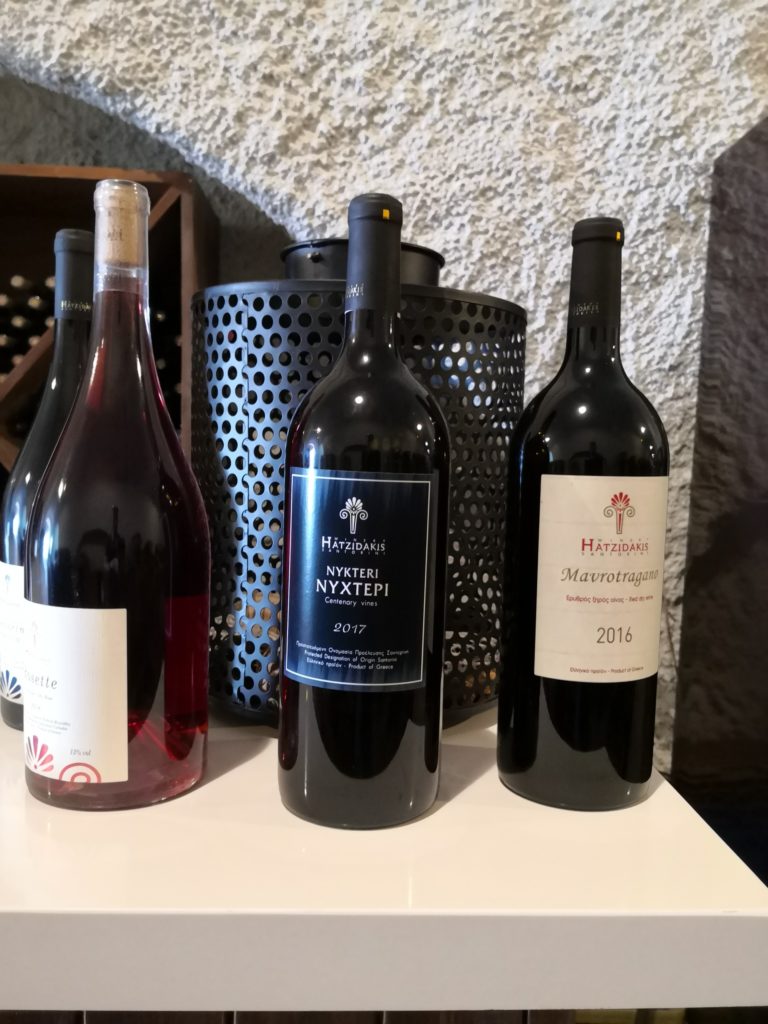 The ending was, obviously, Nykteri. 2017. A wine that, by definition, is made from grapes collected late, which are pressed during the night time, in order to avoid heat and increased oxidation. And a wine that, following the norm, has to stay in wood for at least 3 months. But at Hatzidakis, the wine stays there for a year, in barrels used for the second and third time. The wine has force, extract, complexity, a very good structure, the mineral notes a sizeable. But it would be a shame to drink it before 2025. Especially if it’s in a Magnum bottle… It was around 17 o’ clock when I finished. I said my goodbyes to the girls and sped out of there…that’s until I got to the car. At 18:30, I had to reach the north of the island again, and meet with Paris Sigalas…
The ending was, obviously, Nykteri. 2017. A wine that, by definition, is made from grapes collected late, which are pressed during the night time, in order to avoid heat and increased oxidation. And a wine that, following the norm, has to stay in wood for at least 3 months. But at Hatzidakis, the wine stays there for a year, in barrels used for the second and third time. The wine has force, extract, complexity, a very good structure, the mineral notes a sizeable. But it would be a shame to drink it before 2025. Especially if it’s in a Magnum bottle… It was around 17 o’ clock when I finished. I said my goodbyes to the girls and sped out of there…that’s until I got to the car. At 18:30, I had to reach the north of the island again, and meet with Paris Sigalas…
Surprises, surprises...
It’s a wonderful experience…beating the brakes off a Fiat 600 on volcanic roads. And, when you’re on a 12% slope and you manage to overtake an elderly man on a bike, the satisfaction is out of this world. The important thing was that I got to Sigalas and I had an EXPERIENCE. A Santorini vertical that took me back to 2003. Without beating around the bush, I’ll tell you that Santorini Sigalas is an Assyrtiko 100% that, after alcoholic fermentation, spends 6 months on yeasts. And it comes out at around 14% alc.vol.
So…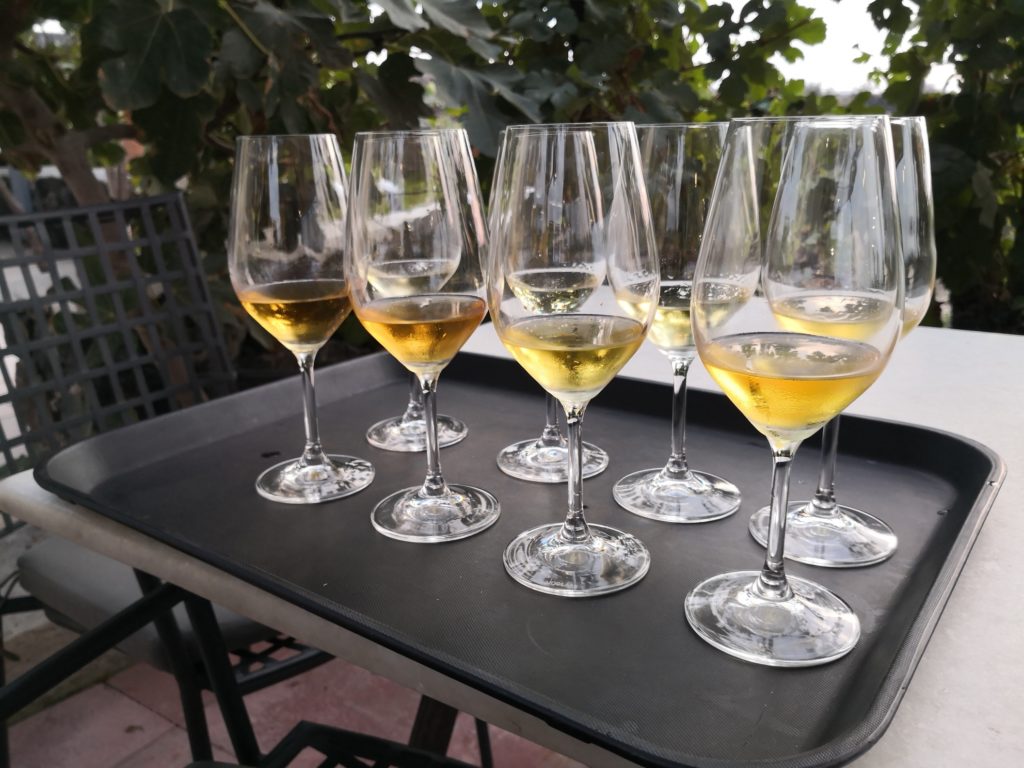
1. Sigalas Santorini 2017 – pretty restrained in the nose, with touches of citrus fruits, white flowers, herbs and a lot of minerality. Firm structure, crunchy acidity, fresh, with notes of lemon and a tonic-mineral ending. 89 p, because it needs to sit for a while…
2. Sigalas Santorini 2016 – More complex fragrances, with tones of sweet citrus, lemon peel, but also a touch of honey. A full taste, with unctuous touches of essential oils and herbs. The finale, long, citric-mineral, sweetened by oxidative touches. – 92p
3. Sigalas Santorini 2015 – Already some gold notes, and the bouquet adds touches of mango and peach over the tipical notes. The minerality pulses and sustains the ample taste, dominated by sweet citrus and white apricot, over which a dusting of white pepper appears. – 91p
4. Sigalas Santorini 2010 – the bouquet talks first, bringing forward notes of honey, lollipop and dried apricot. The lemon is also present, especially in the taste which was full, sweet, with balsamic notes, but very well structured and with a surprising balance. The finale is long, with elegant mineral touches. -93p
5. Sigalas Santorini 2008 – Amber in its robe, Porto in expression. Because the oxidative touches also come with notes of honey, cocoa, herbs, even some tobacco. The body suffers, the alcohol and the acidity don’t get along as much anymore, but the ample finale, with sweet notes of dried orange, raisins, walnuts and mineral touches still please you for 88 points.
6. Sigalas Santorini 2007 – Same same, but not quite. Or, to be easier to understand, same color, but a different expression. At least olfactively, because the volcano is fully present in this wine. The minerality sustains sweet notes of tiramisu, honey and green walnut jam. The body is finer, but the balance is incredible, and the taste is long, without interruptions, with notes of orange peel. 94p
7. Sigalas Santorini 2005 – Surprises, surprises… because the wine still has green lickerings. And it represents minerality to perfection. Which constantly pulsates between notes of sweet lemon, warm herbs, white pepper and roasted seeds. In its long finale, with oily sensations, you find saline touches and notes of green olive. Maybe the most beautiful expression of Greece and Santorini in a single wine. But it’s not easy to understand. I liked it. A lot. 95p.
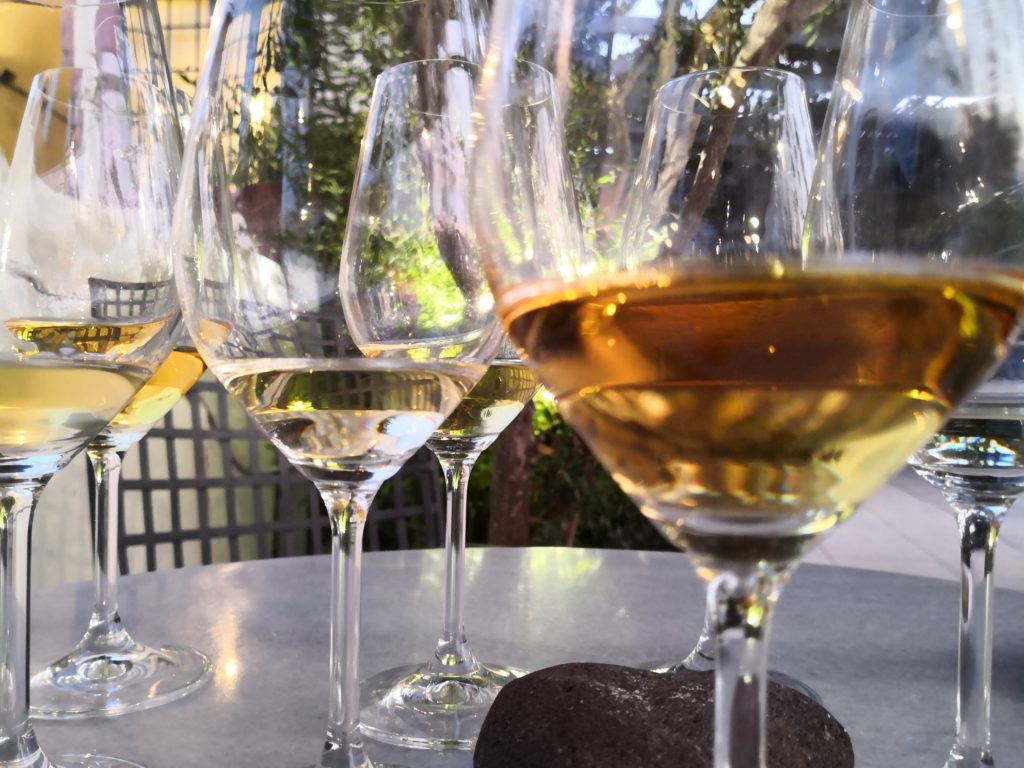 8. Sigalas Santorini 2003 – Ecce Vinum! Or balance in its purest state. Expression of a young Santorini, with lemon, salt, peach, herbs, olives. The type of wine you’re happy exists. Thank you, Paris Sigalas!!! 97p
8. Sigalas Santorini 2003 – Ecce Vinum! Or balance in its purest state. Expression of a young Santorini, with lemon, salt, peach, herbs, olives. The type of wine you’re happy exists. Thank you, Paris Sigalas!!! 97p
I didn’t only limit myself to these wines. I told stories alongside Paris Sigalas, time in which I took joy in a Mavrotragano 2015, Kavalieros 2015 and 2014, a Roptro 2013, an Aidani demi-sweet late-harvest, with three years of wood and two more in a bottle. And I also tested the wines which, in Paris’ opinion, will assure the survival of the winery in a pretty muddy period. Cabernet Sauvignon and Syrah, both from 2018, both made by grapes coming from the continent. The wines will be on the market in 2020. We’ll talk more about them then…
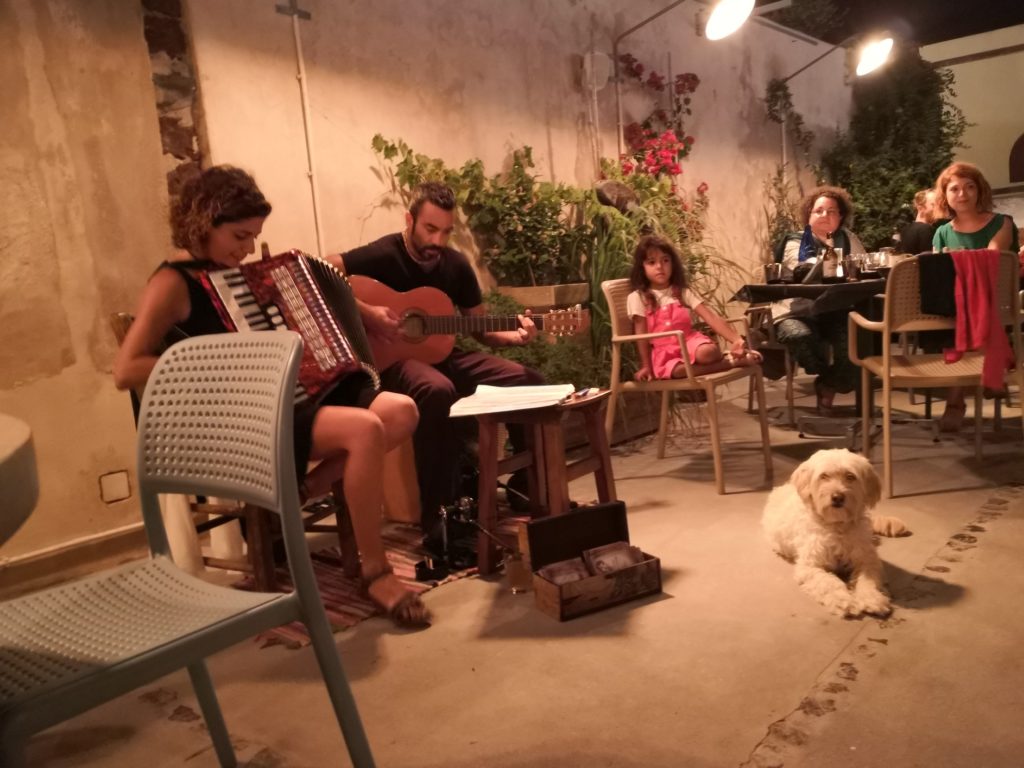 I left at around 22:30. Not to Kamari, but to Oia. Where a good friend, Panayiota Kalogeropolou, invited me to a special night in a place I recommend with all my heart : Vineyart. I got to experience old music, reinterpreted, typical cyclade cusine, good and very good wines – they have older wines as well, so… – and wonderful people around me. I want more!
I left at around 22:30. Not to Kamari, but to Oia. Where a good friend, Panayiota Kalogeropolou, invited me to a special night in a place I recommend with all my heart : Vineyart. I got to experience old music, reinterpreted, typical cyclade cusine, good and very good wines – they have older wines as well, so… – and wonderful people around me. I want more!
Day 3
At 8:00 I was on the beach in Kamari again. Same impeccable water, same planes, same 4 euro double espresso. Deja-vu. I got to my room at around 2 in the morning, but I wasn’t tired. That Volcano Energy… I can’t sit too much, at 10:30 I have to be at Gaia. Where, if I get lucky, I might catch Yiannis Paraskevopoulos around, enologist and one of the share-holders of the trust. Yes, trust, because Gaia has it’s main winery in Peloponese, and Yiannis is also a share-holder at Santorini Brewing Company. And titular professor in Enology in Athens. And a special man, balanced and with an acute sense of humour. I tried and tried to meet him since 2015, but, for some reason, when I was in Santorini he was in Peloponese. And vice-versa…
Gaia Wines
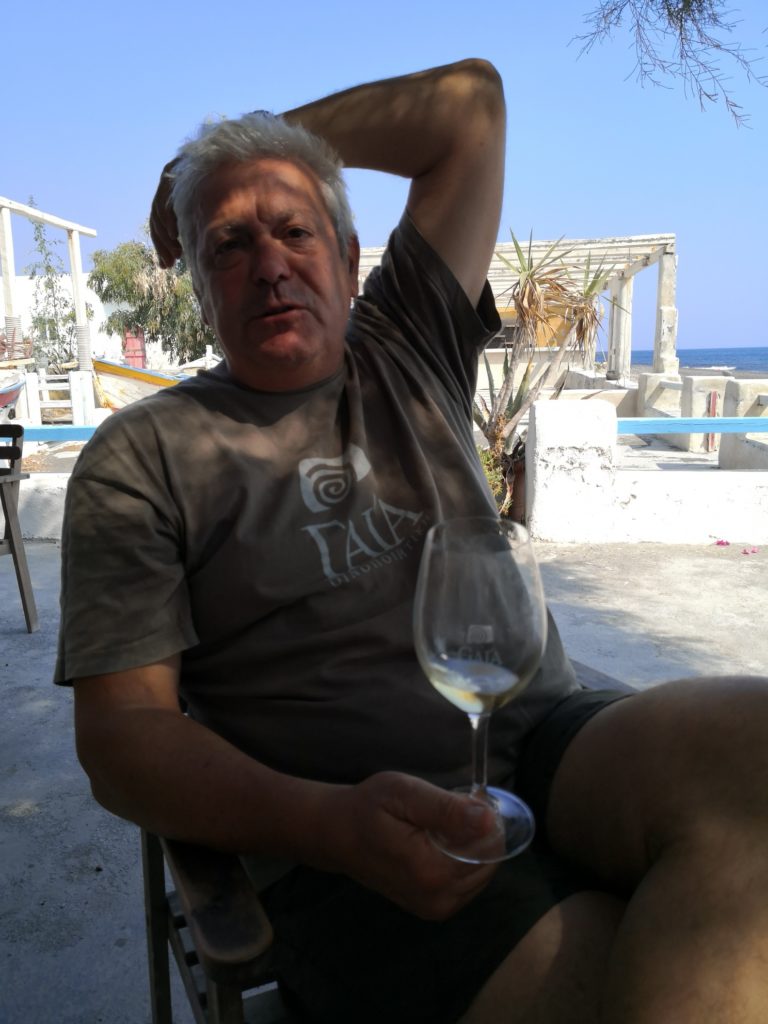 I did catch Yiannis. It was his last day in Santorini. He finished harvesting the grapes, but he stuck around because he had to put 500 bottles of Thalassitis 2018 under water. Which, in over at least 4 years (usually the wine is left in the sea for 5 years), will become Thalassitis Submerged 2018. The professor will always be a professor. Always up to date with studies in the field, he knows exactly what he wants. He seems to be the most relaxed person on the island. He explained to me, shortly, why he takes the wines at see and submerges them 30 metres deep, leaving them there so many years. It’s about both the more highlighted oxygen exchange, and some principles of biodynamics, because the sea is a powerful energetic center. Above that, because of the slow changes in temperature, and through the somehow oscillating movement, the wine goes through way more modifications, especially when it comes to organoleptic characteristics. He also told me why he uses honey during vinification, explained the paradox of the extremely reduced pH of Santorini wines, why he’s more of a fan of the reductive style and why he uses a little bit more sulf for wine-protection (a lot under the allowed limit!!)
I did catch Yiannis. It was his last day in Santorini. He finished harvesting the grapes, but he stuck around because he had to put 500 bottles of Thalassitis 2018 under water. Which, in over at least 4 years (usually the wine is left in the sea for 5 years), will become Thalassitis Submerged 2018. The professor will always be a professor. Always up to date with studies in the field, he knows exactly what he wants. He seems to be the most relaxed person on the island. He explained to me, shortly, why he takes the wines at see and submerges them 30 metres deep, leaving them there so many years. It’s about both the more highlighted oxygen exchange, and some principles of biodynamics, because the sea is a powerful energetic center. Above that, because of the slow changes in temperature, and through the somehow oscillating movement, the wine goes through way more modifications, especially when it comes to organoleptic characteristics. He also told me why he uses honey during vinification, explained the paradox of the extremely reduced pH of Santorini wines, why he’s more of a fan of the reductive style and why he uses a little bit more sulf for wine-protection (a lot under the allowed limit!!)
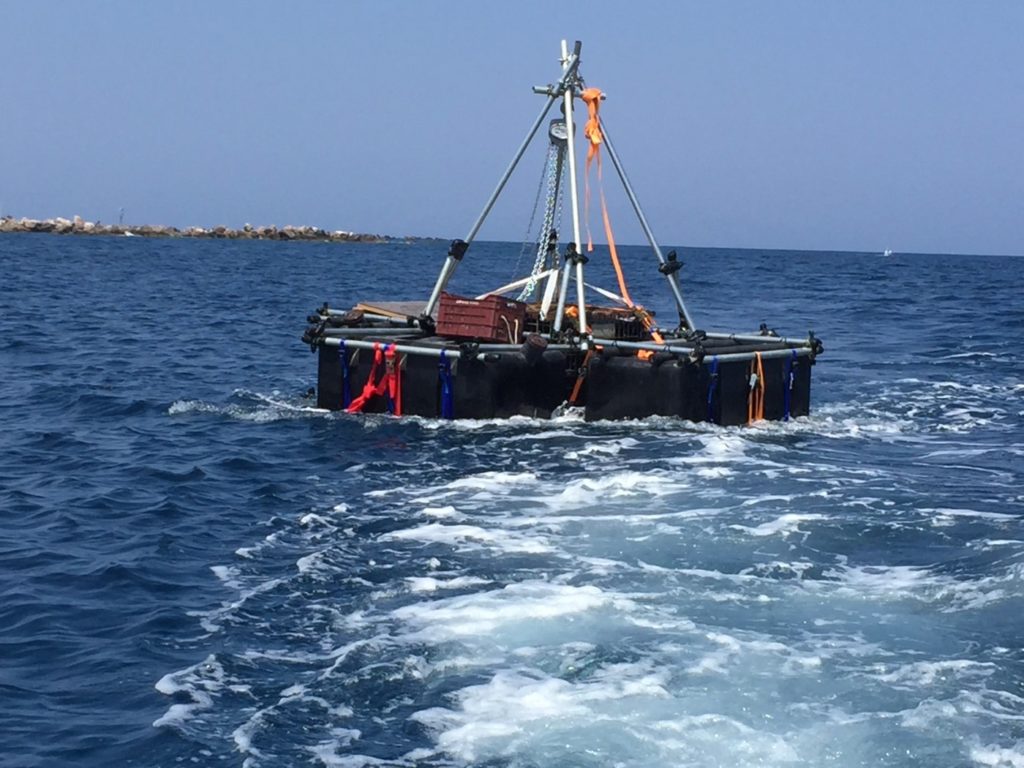 While we waited for the truck to come and lift the pallet that was to be submerged in the sea, we talked about the island. Yiannis doesn’t see that bright of a future for Santorini wine. “Our vine is specific. You can’t take care of it easily. It is an old vine, hundreds of years. And the work force is smaller and smaller. For a long time, the vines were mostly worked on by immigrants. But the second generation behaves the same way as Greeks do: they don’t want to work in agriculture anymore”.
While we waited for the truck to come and lift the pallet that was to be submerged in the sea, we talked about the island. Yiannis doesn’t see that bright of a future for Santorini wine. “Our vine is specific. You can’t take care of it easily. It is an old vine, hundreds of years. And the work force is smaller and smaller. For a long time, the vines were mostly worked on by immigrants. But the second generation behaves the same way as Greeks do: they don’t want to work in agriculture anymore”.
Not only workforce is the problem. The production of the island is getting smaller and smaller. “Usually, the production decreases by 3.7% year by year. And in the past few years, the price of grapes has risen by 400%. And that’s not just because of the newcomers. There are a lot of people who came here because they realised the sort of impulse it could represent for their business, but a lot of them were obligated to do so because the importers imposed their will << You don’t have Santorini? Then we will go somewhere else >> And they needed to make a place for themselves. Which, in a way, is unfair towards people like Sigalas, Argyros, Hatzidakis, Gavalas, like myself, people who worked hard to make the name, the brand of Santorini”, said Yiannis Paraskevopoulos. And another problem is the exacerbated rise in wine prices. “They now cost as much as a good Bourgogne. The problem is that, as of now, people aren’t paying for Greece”.
The discussion leaves a sour taste. Yiannis helps sweeten that with, initially, a Thalassitis 2018, then, with an Assyrtiko by Gaia – Wild Ferment 2018. The last of which, a poem! Vinified 45% in a tank, 45% in different barrels, wood wise and use wise. The remaining 10% is vinified in egg-like amphors, made by pressed ceramics, which Yiannis seals with honey. “Because honey lets oxygen get in, but doesn’t let wine go out. It also serves an antibacterial role”.
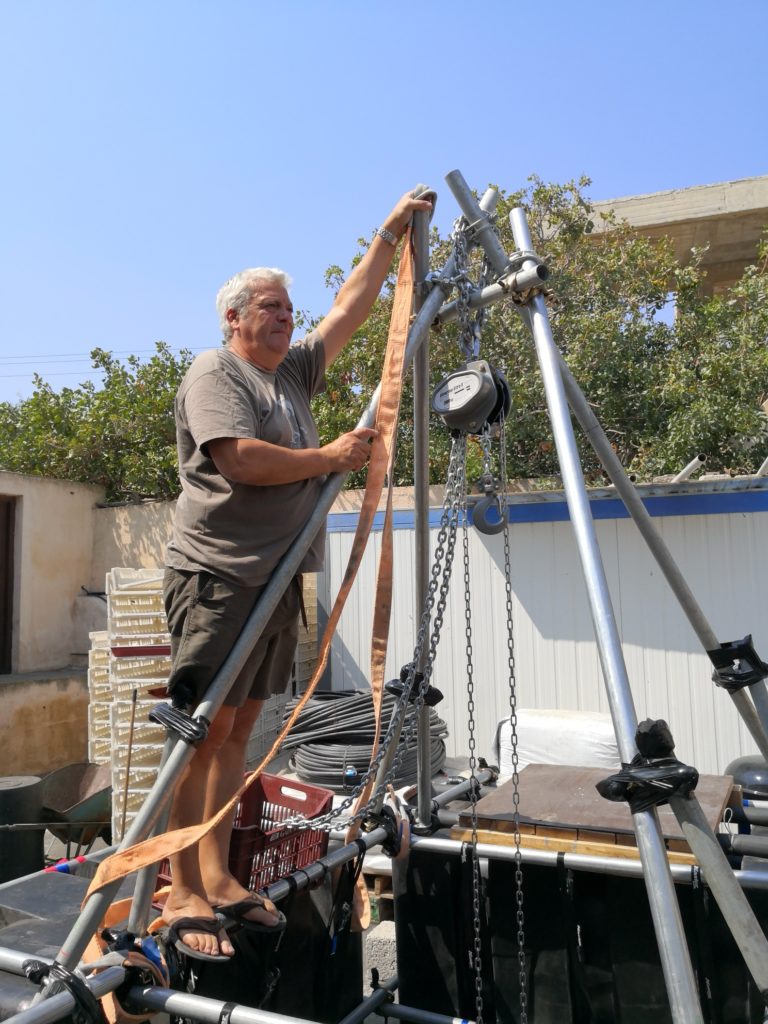 The truck arrived. I take a glimpse at the procedures. Even though he’s the owner, Yiannis works the hardest. He ensures the pallet, ties the hinges. He has to be sure he doesn’t lose a single bottle. He can’t afford that, considering that, in 2019, he’ll only produce 60% of what he usually does…
The truck arrived. I take a glimpse at the procedures. Even though he’s the owner, Yiannis works the hardest. He ensures the pallet, ties the hinges. He has to be sure he doesn’t lose a single bottle. He can’t afford that, considering that, in 2019, he’ll only produce 60% of what he usually does…
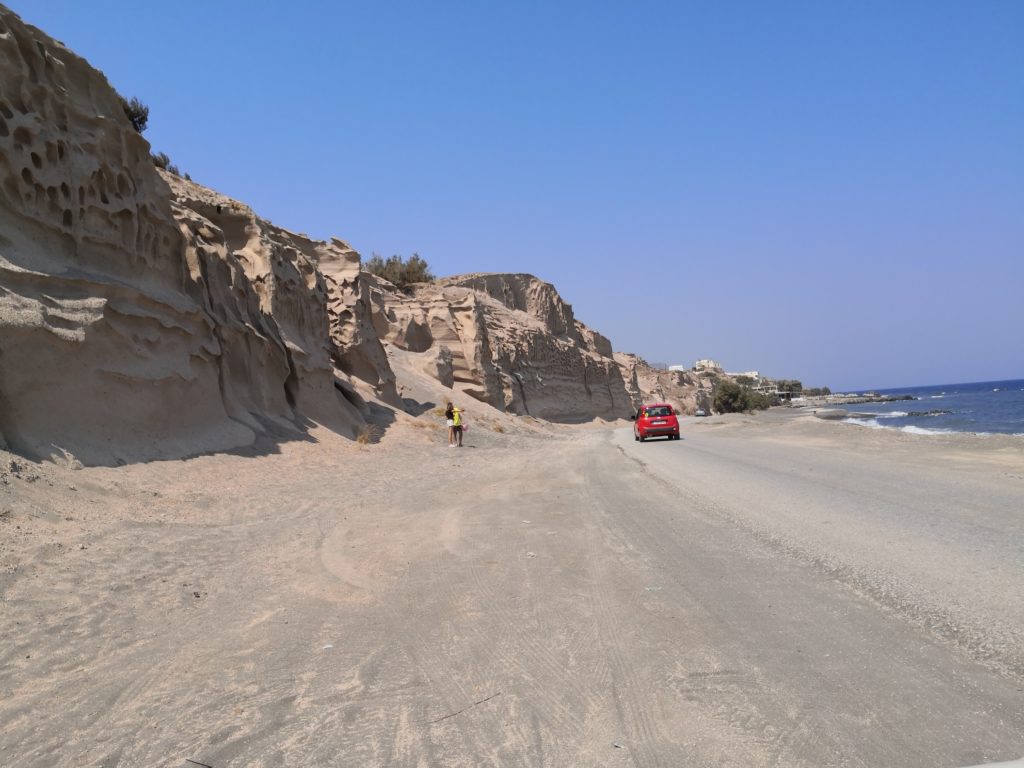
Avantis Cellar Doors
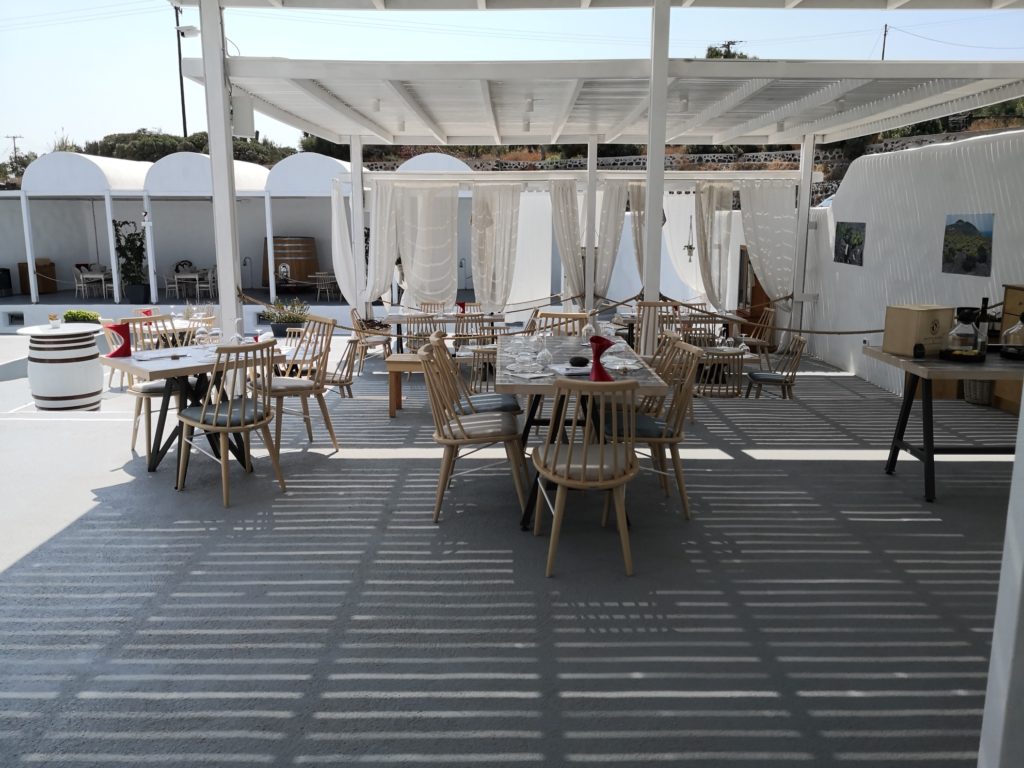
On the road again. I have to get to Kontochoriu, at Avantis Cellar Doors. Not at the winery, which is situated pretty close by, in Vothonas, but rather at the enoturistic centre of Avantis, organized on the place of the old open-air cinematograph of Fira. The place is superb. Sure, I was expecting something beautiful, not only because I saw pictures, but also because I know the good taste and imagination that characterises Lenga Grigoriadou. I saw the transformations suffered by the Avantis winery in Evia a few years ago with my own eyes, so I wasn’t so surprised by the arrangement of the place. I was even more enthusiatic when I found out about the kitchen, which is at its finest at Avantis Cellar Doors. But I’m not here to talk about Octopus on a bed of Fava here, so we’ll get back to wines and the problems of the island. And I talk about them with Lenga, who came from Evia especially to greet me and show me the creation. Thank you, Lenga!!!
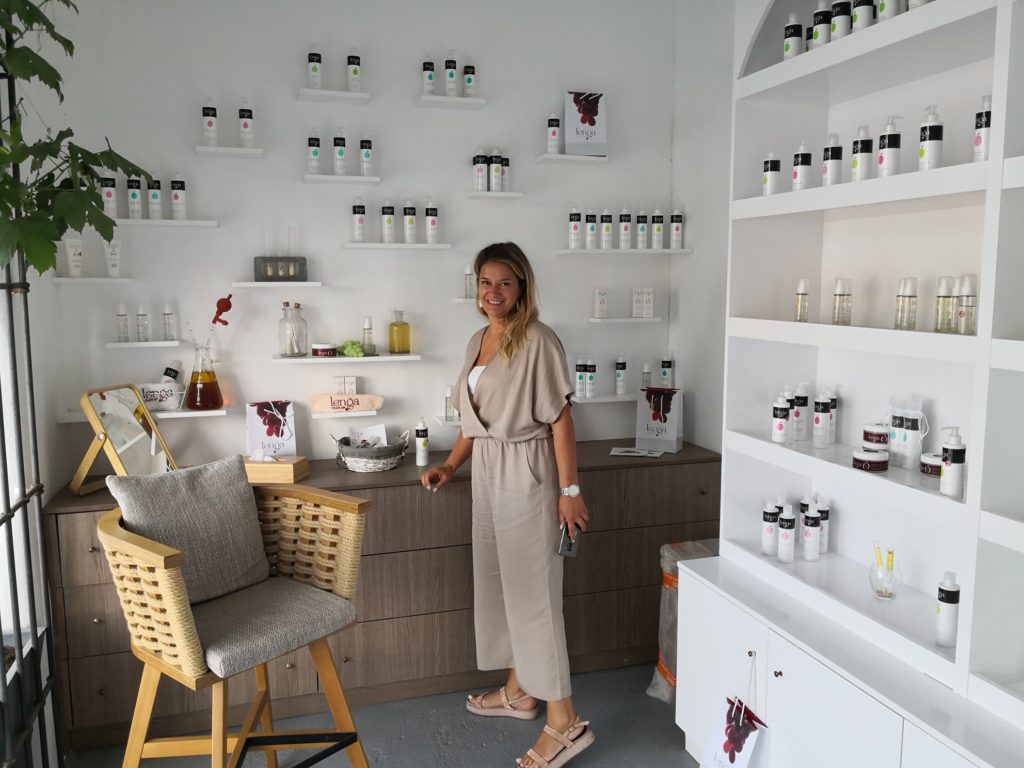 “It wasn’t the best year”, Lenga starts confessing. “The harvest was very weak, especially whites. But the quality of the wines will be incredible. Especially Atihiri, which Apostolos (n.a. – Apostolos Mountrichas, husband of Lenga and winemaker at Avantis Estate), will separately vinify for the first time this year. It already fermented in tanks, it’s now on yeasts, in cement vases. But our production will be 50% smaller than in previous years. So that means only around 15.000 bottles. Even if we paid between 4,5 and 5 euro per kilo of grape”.
“It wasn’t the best year”, Lenga starts confessing. “The harvest was very weak, especially whites. But the quality of the wines will be incredible. Especially Atihiri, which Apostolos (n.a. – Apostolos Mountrichas, husband of Lenga and winemaker at Avantis Estate), will separately vinify for the first time this year. It already fermented in tanks, it’s now on yeasts, in cement vases. But our production will be 50% smaller than in previous years. So that means only around 15.000 bottles. Even if we paid between 4,5 and 5 euro per kilo of grape”.
Apostolos and Lenga, who is also an enologist, started making wine in Santorini in 2012. So they fall in the newcomer category. I asked Lenga if that conflict between locals and newcomers exists. “It isn’t a conflict, but there are some complaints, some accusing words. However, in the actual situation, we should forget about them and unify, so we could save what could be saved. We have to protect the lands with vines on them, which dissapear year by year. I know that the newcomers are accused of not caring about the vineyards, but that is not true. We kept on trying to buy, but it is very hard. People here have started to become way more interested in tourism than in vine, whoever has a field would much rather build a pension, than sell it. I hope that next year we’ll be able to buy our first two hectars here, on the island, but we also want to take some under administration, with long term contracts”.
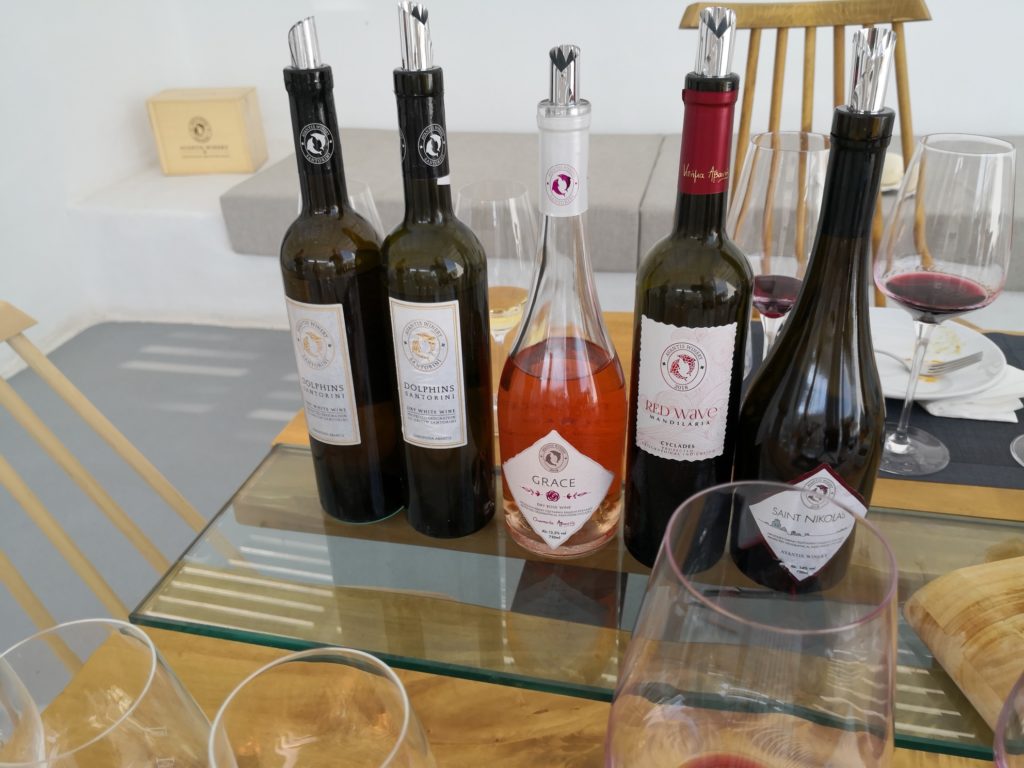 We start the tasting. Not a lot of wines, because I have a “Sei Cento” to drive. So I’ll just stick to a Dolphins Santorini 2017 and 2018, Grace 2018 (rose from Mandilaria), Red Wave Mandilaria 2018, the newly-born Sain-Nikolas 2018, a blend of Mandilaria and Mavrotragano, but also the sweet Islander 2018, made out of seven varieties of grape.
We start the tasting. Not a lot of wines, because I have a “Sei Cento” to drive. So I’ll just stick to a Dolphins Santorini 2017 and 2018, Grace 2018 (rose from Mandilaria), Red Wave Mandilaria 2018, the newly-born Sain-Nikolas 2018, a blend of Mandilaria and Mavrotragano, but also the sweet Islander 2018, made out of seven varieties of grape.
Just as I expected, Dolphins 2017 is fuller than its younger brother. Because a part of it was kept in wood, but also because the year was better. Both of the wines are 100% Assyrtiko, made by grapes that came from Fira and Kharterados. Both sit on yeasts for two months. In the case of the Grace rose, we find the same thing. 2018 is more light that the rose from 2017. With a more floral-mineral expression, although it is made exactly the same, so just pressing and fermentation, without pelicular maceration, because, you knew, right?, Mandilaria is also a tinctorial variety, that means it has red pulp. The name, Grace, comes from the plot where the grapes are made, which is really close to Agia Faneromeni church, next to Pyrgos. Red Wave, a new entry, is an 100% Mandilaria with 13.5% alc.vol. The grapes come from plantations in Kamari and Exegonia. Maceration lasts two days, followed by fermentation in an Inox tank. And it has some surprisingly silky tannins for a Mandilaria so young. Although still very young, Saint Nikolas 2018 is a wine which is way more dense and expressive. Because it has 10% Mavrotragano, but also because, after they were vinified separately, the wines were kept together in a 300 litre barrel for nine months. A single barrel, that’s why only 400 bottles were produced. It comes with a wonderful note of sour cherry, over which you find touches of chocolate, herbs and condiment. And with aging potential of at least 7 years. I’m not gonna tell you that much about Islander. 14% alc.vol, seven varieties, half of the grapes being late-harvest, the other half, sun dried… But it’s only sold in Santorini…
I went beyond 17 o’clock, so I didn’t get to reach my last objective, Santorini Brewing Company. The one that produces the Donker beer range, which I discovered two years ago. All bad leads to good, because I get to take care of important business! By that, I mean fitting the many bottles I bought into a troller and a small little kiddy rucsack. And to get to the “End of Harvest” party organized at Artemis Karamolegos Winery. Where I saw most of the many people I got to meet during the three days of enological wandering. I didn’t stay there for too long, I left at 1 A.M, because at 6:40 I had to catch a ferry… Farewell, Santorini!
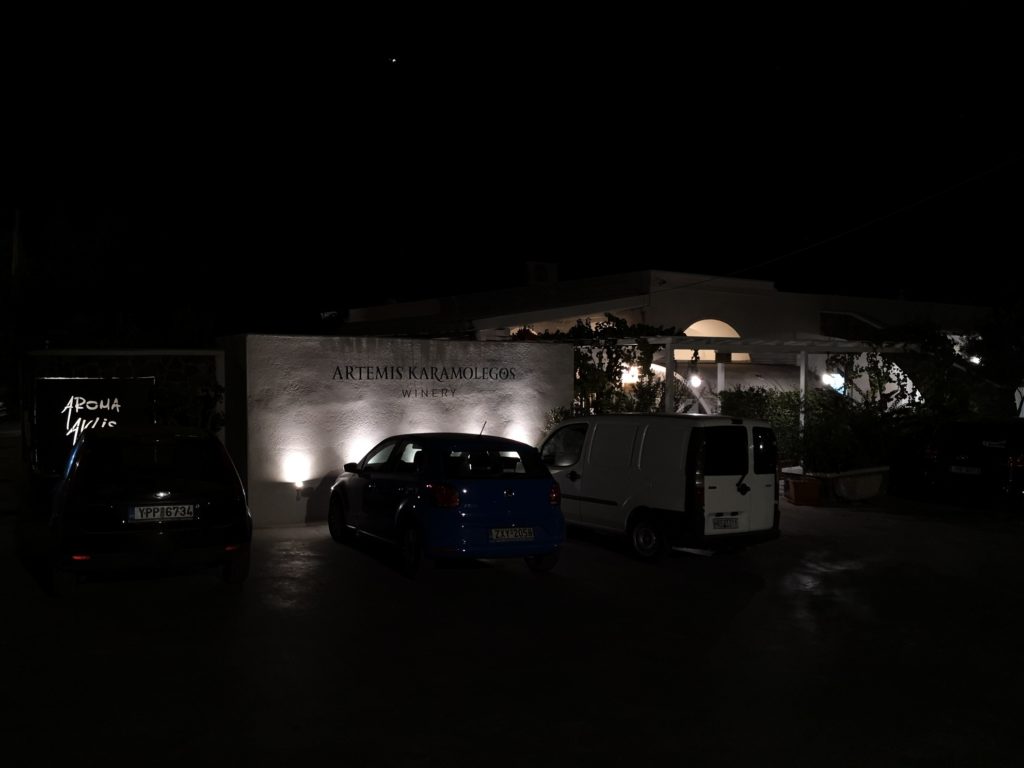
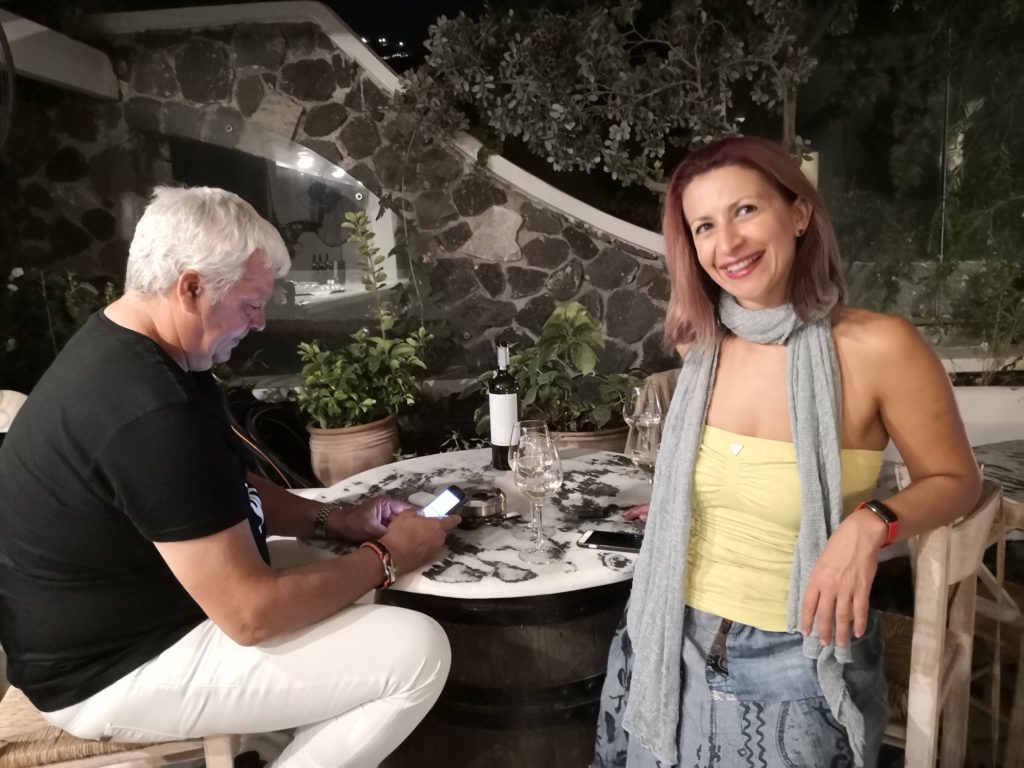
Mikra Thira
No, I didn’t finish yet. I did leave the island, but our documentary continued on continental Greece. Because that’s where I met up with Vanghelis Gerovassiliou. A man who, if you didn’t know, recently started a project of his own in Santorini. Alongside his partner, Vassilis Tsaktsarlis, but also alongside Ioanna Vamvakouri, an enologist who owned 1.5 hectars of vine on Thirasia, the small island that broke off from Santorini after the big eruption 3619 years ago. Mikra Thira, because that’s what the project is called, now owns 4 hectars of vine in Thirasia and buys grapes from Santorini. Only Assyrtiko and only enough for 10.000 bottles. The winery, situated on the small island, Thirasia, only produces two wines, for now: Mikra Thira Santorini, wine made only with the grapes they buy from the big island, and Mikra Thria Terrasea, made with the grapes from their own plantations. “We had a bit of luck, because our vines from Thirasia started producing a bit more. Compared to last year, we’ll make less wine, but only by 10-15%. So we’re way better off than others. The big problem is the future, because there’s not many people willing to work in the vineyard anymore. We got to the point where we’re paying 50 euros a day to whoever comes to help with collecting and cutting. And that’s not the whole story. With the way prices of grapes are going, any Santorini bottle will get to the price of at least 12 euro. That’s only to cover production costs. If producers also want profit, they’ll have to raise the price up a bit. But who’s going to pay 15-16 euro for a Santorini straight from the winery? I think only producers who will branch out on the enotouristic side will survive”, saide the great enologist from Greece. Vanghelis Gerovassiliou confessed that he wants to buy more plots in Thirasia, but the procedure is very difficult, because the only plots up for sale are owned by people who don’t live on the island anymore…
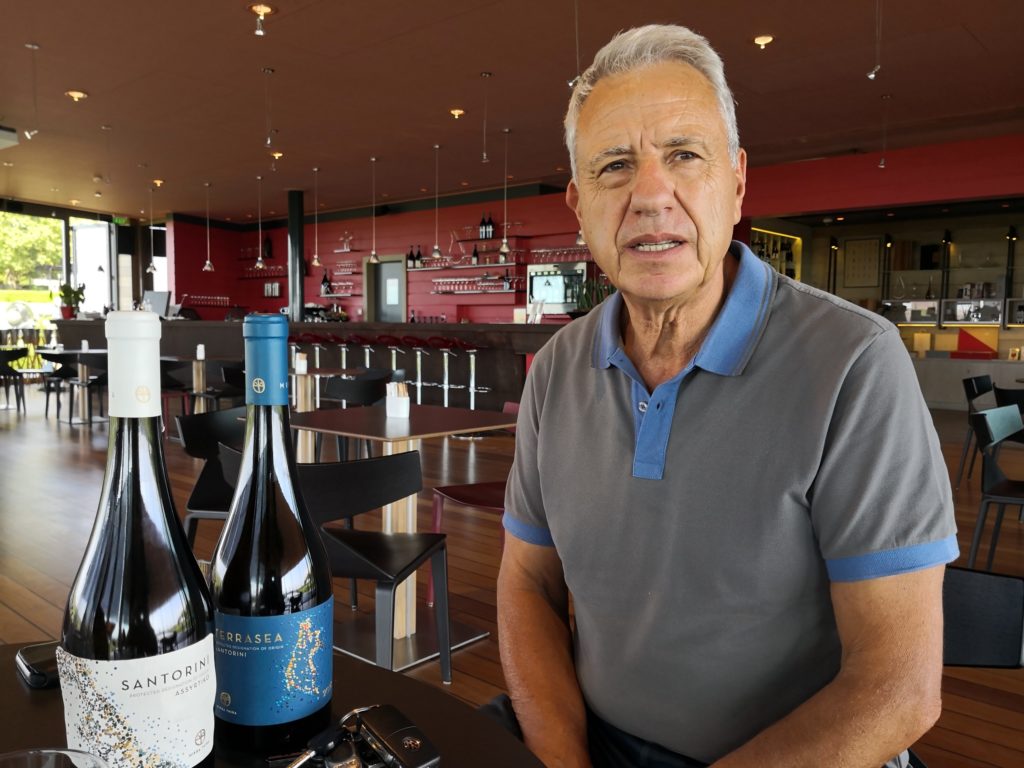 I didn’t taste the wines. Yet. I mean, I tasted them, back in the start of April, at a wine saloon organised in Thessaloniki, where the wines were presented for the first time. But they were extremely young then. I only remember that I was more impressed by Terrasea, which had a distinct minerality to it. Now, my personal collection takes pride in having both of the labels of the Mikra Thira project. I effectively took them by force from Vanghelis Gerrovassiliou. They were the only bottles left at his Epanomi domain, but I cried and begged so much that he gifted them to me. It was the only way, I didn’t find them in Santorini…
I didn’t taste the wines. Yet. I mean, I tasted them, back in the start of April, at a wine saloon organised in Thessaloniki, where the wines were presented for the first time. But they were extremely young then. I only remember that I was more impressed by Terrasea, which had a distinct minerality to it. Now, my personal collection takes pride in having both of the labels of the Mikra Thira project. I effectively took them by force from Vanghelis Gerrovassiliou. They were the only bottles left at his Epanomi domain, but I cried and begged so much that he gifted them to me. It was the only way, I didn’t find them in Santorini…
Quo Vadis, Santorini?
Santorini is a myth. A beautiful island, with a story that gets written day by day, thanks to the sea, the sun, the volcano, its people and the tens of thousands of tourists who visit yearly. The wine from Santorini, also, has its special place in this story. Just like the donkeys, the tomatoes, the white aubergines, fava, capers. Things that people have barely talked about. In the past few years, Santorini Assyrtiko was poised to become the new Gruner Veltliner of wine. A brand that could’ve carried all greek wine on its back. Or at least that’s how I saw it. And not only I. Now, the brands seems shaken up. The higher prices led to some commercial canals being shut down, and producers get to suffer. Sure, there will always be people willing to pay 50 euros for a Santorini, especially right there, in its home. But outside? Where maybe the price will be even higher? Higher than even a Premier Cru from Bourgogne? 2019 sounded the alarm. If in the previous year – which wasn’t good at all, to make it clear – the total production of the island was of 1886 tonnes of grapes, this year it barely scraped 1300! Back in 2009, there were 1100 hectars of vine and 7 producers. Now, there’s only 900 hectars, the grapes of which are being shared by 19 producers. Some people say there’s even more, around 22. And, as far as I know, there still are big names in Greek wine that are thinking about coming to Santorini. Sure, there are also some producers ready to close down the shop. For various reasons. The others adapt as they can. I can’t put Paris Sigalas’ sadness into words, when he told me about reaching the point of buying grapes from the continent in order to survive. But will he survive? Is it enough to be a big name in order to be able to sell Syrah made in Santorini?
All the producers on the island think something must be done. But what, when, and who’s gonna start? Everybody hopes that, after the rains this year, 2020 will bring a good harvest again. But will the price of grapes and, obviously, of wine, go down?
Paradoxally, while a myth, Santorini doesn’t crack the top of the most expensive destinations in Greece. Hydra, Mikonos and Spetses are way more expensive. And the three islands I just mentioned cannot say that they produce so and so wines. I’d like to know if there’s any people who only visit Santorini for wine? Or what percentage of them arrive on the island also for wine? Sure, the big percentage is made up of people who come for the resorts, the weddings and windmills in Oira and for the sunsets seen from the edge of the Caldera.
I believe that, even without wine, Santorini will remain a myth. But the sunsets will not be as beautiful…